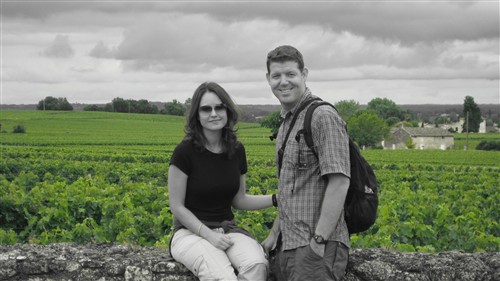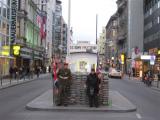Posted under France
 Our road trip continued south toward Bordeaux where bright yellow fields of sunflowers were soon interspersed with sprawling vineyards. On the way, Aaron found the picture-perfect patch of sunflowers so we got out of the car and leaped a narrow ravine (at which time I was reminded that I wasn’t ready to be leaping ravines just yet) to capture the moment. On the way back, a chivalrous gent with big cheeks carried me across like a princess. We arrived in Bordeaux in mid-afternoon and Aaron and Valerie ventured out for a walk while I opted for a few solitary hours of recovery time.
Our road trip continued south toward Bordeaux where bright yellow fields of sunflowers were soon interspersed with sprawling vineyards. On the way, Aaron found the picture-perfect patch of sunflowers so we got out of the car and leaped a narrow ravine (at which time I was reminded that I wasn’t ready to be leaping ravines just yet) to capture the moment. On the way back, a chivalrous gent with big cheeks carried me across like a princess. We arrived in Bordeaux in mid-afternoon and Aaron and Valerie ventured out for a walk while I opted for a few solitary hours of recovery time.
The next morning began with a leisurely stroll through the Bordeaux Sunday market. The rows of vendor stalls selling fruits and vegetables, fresh fish, bread, pastries, meats, cheeses, olives, wine, locally harvested oysters, and scrumptious tapas and prepared foods lined the wide River Garonne and filled the air with tantalizing aromas. Locals abounded with their signature French woven baskets, filling them with items for the day’s meals. After perusing every stall, we selected a large bowl of mussels béarnaise and a baguette for a picnic brunch.
Our destination for the day was the historic town of St Emilion, known for its vineyards and full-bodied red wines. The scenic 40km drive landed us in the medieval stone village before noon. We stopped to admire the golden-hued stone walls and the expanse of vineyards beyond. The town’s only tourist site was a monolithic church built underground by monks from the 9th-12th centuries. We stopped into the tourism office to buy tickets for the English tour and then had a couple of hours to tool around town on our own before it began.

The village was built entirely of limestone. Once a wheat-producing community, the St Emilion of today is entirely devoted to wine. The narrow cobbled streets are lined with boutique wine shops, restaurants and hotels oozing charm. So dedicated is the village to wine tourism, that there is one wine shop for every four residents. Window shopping among these wine boutiques enticed us to indulge and, after a tasting in one of the shops, we decided to relax at one of the ubiquitous sidewalk cafés, sipping wine until tour time. The quartet of musicians that had lured us to that particular square stopped making merry just after we sat down but there were plenty of interesting people to keep us entertained.
 The town was named after a monk, Emilion, who settled there in the first century, living a hermit’s life in a stone cave for 17 years. Our tour began with a short descent into Emilion’s cave, which consisted of two “rooms” with a bed, a meditation seat, and a small pool from an underground river. Our guide explained that Emilion’s meditation seat is believed to have powers of fertility and that 70-80% of women who sit on the seat send letters attesting to its magic. Guess whose buns were the first ones onto that seat? And once more on the way out…just in case the power didn’t soak in the first time.
The town was named after a monk, Emilion, who settled there in the first century, living a hermit’s life in a stone cave for 17 years. Our tour began with a short descent into Emilion’s cave, which consisted of two “rooms” with a bed, a meditation seat, and a small pool from an underground river. Our guide explained that Emilion’s meditation seat is believed to have powers of fertility and that 70-80% of women who sit on the seat send letters attesting to its magic. Guess whose buns were the first ones onto that seat? And once more on the way out…just in case the power didn’t soak in the first time.
We descended next into the historic town crypt where monks, men of status, and male babies were once buried. In those days, women were believed not to have souls so they were buried in the outlying fields. The crypt had long since been plundered of its treasures and remains but we were able to see the individual underground graves carved into the stone and the tiny carve-outs for the babies.
Finally, we entered the monolithic church. “Monolithic” means one level or one piece. The church was built underground for protection from Vikings and violent religious persecutors. Limestone blocks were excavated through small openings at the top. The depth of the interior was astonishing. There were only faint remnants of the original iconography and the limestone pillars had been recently reinforced by sturdy metal braces but the cool, damp, cavernous interior enveloped our senses and called to mind visions of devout worshippers bowed in candlelit prayer. On one Sunday each month, services are held in the monolithic church in commemoration of its founders.
As we exited the church into a burst of golden sunlight, I turned to gaze upon the entrance once again. I imagined the intense labor involved in creating this massive underground church by hand. Naturally, it would have been easier to build the church above ground but the reality of religious persecution forced the community to conceal and protect themselves in practicing their faith.
The draw of St Emilion is certainly its wine but the town has a fascinating history, which can be absorbed in less than an hour. Like so many charming French towns, the artistry, architecture and bright summer flowers create an ambience that makes you feel as though you’re walking around in a painting. France makes me want to fling my crusty backpacker duds onto a rooftop, don a pretty dress and stylish chapeau, and fold artfully into the scene.
Comments Off on St Emilion

 The highlight of the day (in my biased, dog-loving opinion) was our final stop at Chateau de Cheverny. I had rested in the car between stops so that I would have maximum stamina for our late afternoon visit. The classical façade, pristinely manicured gardens, expansive grounds and magnificent period furnishings were a true pleasure to admire. However, we had come for a different thrill: the soupe des chiens, or feeding of the dogs. “As was the custom among the nobility of centuries past, Marquis Charles-Antoine de Vibraye – whose family has owned Cheverny since it was built – hunts with dogs.” Most of his 100 canines are a cross between English fox hounds and French poitevins. (Lonely Planet France: Jan 07).
The highlight of the day (in my biased, dog-loving opinion) was our final stop at Chateau de Cheverny. I had rested in the car between stops so that I would have maximum stamina for our late afternoon visit. The classical façade, pristinely manicured gardens, expansive grounds and magnificent period furnishings were a true pleasure to admire. However, we had come for a different thrill: the soupe des chiens, or feeding of the dogs. “As was the custom among the nobility of centuries past, Marquis Charles-Antoine de Vibraye – whose family has owned Cheverny since it was built – hunts with dogs.” Most of his 100 canines are a cross between English fox hounds and French poitevins. (Lonely Planet France: Jan 07).